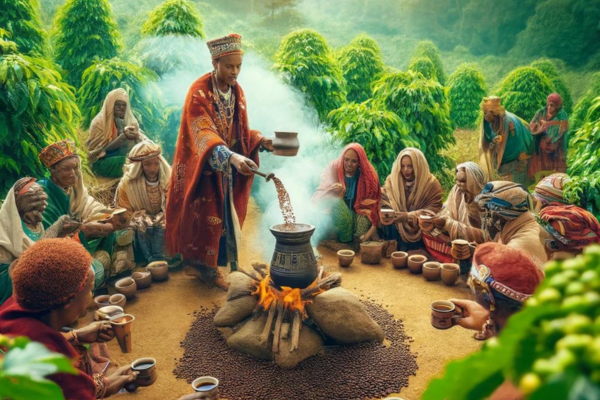The Birth of Coffee: Origins in Ethiopia
Coffee’s journey began in Ethiopia, where legend says a goat herder named Kaldi discovered its energizing effects. Observing his goats becoming lively after eating coffee berries, Kaldi tried them himself, experiencing the same vitality. This discovery led to the local use of coffee beans, ground and mixed with animal fat, as a stimulant.
Monks soon realized coffee’s potential to aid their nocturnal prayers, boiling the berries to create a primitive form of the beverage. These early methods of coffee consumption set the stage for its evolution into a global phenomenon, transitioning from a local secret to a sought-after commodity across trade routes.
As coffee’s popularity grew, its cultivation spread to nearby regions. By the 15th century, it had reached Yemen, where the climate was ideal for growing the coffee plant. In Yemen, the coffee bean was first roasted and brewed in a manner similar to how we prepare it today, marking a significant advancement in coffee consumption.
Coffee Houses and Social Revolution
The establishment of coffee houses in the Arabian Peninsula transformed coffee from a home-brewed drink to a social phenomenon. These public spaces, originating in the 15th century, became centers for social interaction, political debate, and cultural exchange, laying the groundwork for coffee’s integral role in social life.
In the Ottoman Empire, coffee houses quickly became popular, serving not just coffee but also as venues for chess, music, and news. This tradition spread to Europe in the 17th century, where coffee houses were dubbed “penny universities” because for the price of a cup of coffee, one could engage in stimulating conversation and networking.
London’s coffee houses became hubs for intellectuals, traders, and politicians, influencing the course of British business and politics. Similarly, in Vienna, the tradition of serving coffee with pastries began, adding a culinary dimension to the coffee culture. These establishments set the foundation for the modern café culture, highlighting coffee’s role in fostering community and conversation.
The Global Trade and Economic Impact
The surge in coffee demand led to its establishment as a global commodity. European colonial powers, recognizing coffee’s profitability, began cultivating it in tropical colonies. The coffee trade became a cornerstone of the colonial economy, with vast plantations in the Caribbean, South America, and Asia.
The 18th and 19th centuries saw coffee become one of the world’s most traded commodities, deeply intertwined with colonialism and slave labor. The economic boom it created contributed to the growth of cities and ports, but also led to exploitation and social injustices, shadowing its economic success.
Today, coffee continues to be a major economic driver, with millions of people involved in its cultivation, processing, and distribution. The industry has faced challenges, such as market volatility and the need for sustainable practices, leading to initiatives like fair trade and organic certification to improve equity and environmental stewardship in coffee production.
Innovation and Evolution in Coffee Culture
The 20th century brought significant innovation to coffee consumption, most notably the invention of the espresso machine in Italy, which revolutionized coffee culture. This led to the proliferation of coffee bars and cafes worldwide, offering a variety of coffee-based drinks and fostering a culture of espresso appreciation.
The late 20th and early 21st centuries saw the rise of the specialty coffee movement, emphasizing the quality, sourcing, and unique characteristics of coffee. Third-wave coffee enthusiasts focus on the art and science of coffee brewing, highlighting the bean’s origin, roasting methods, and brewing techniques, which have elevated coffee from a mere commodity to a gourmet product.
The internet and globalization have also played pivotal roles in spreading coffee culture, with online communities and coffee blogs sharing brewing tips, reviews, and coffee knowledge, further enriching the coffee experience for enthusiasts around the globe.
Sustainable Futures: Coffee in the 21st Century
As coffee culture continues to evolve, sustainability has become a central theme. The coffee industry faces challenges like climate change, deforestation, and labor issues, prompting a shift towards more sustainable and ethical practices. Consumers are increasingly supporting brands that prioritize fair trade, organic production, and direct relationships with growers.
Innovations in coffee farming, such as shade-grown coffee, agroforestry, and water conservation techniques, are improving the environmental impact of coffee cultivation. These practices not only protect the ecosystem but also produce higher quality beans, aligning with the demand for premium, sustainably sourced coffee.
The future of coffee lies in balancing tradition with innovation, ensuring that this beloved beverage remains a source of pleasure and livelihood for generations to come, while respecting the earth and the people who cultivate it. The transformation of coffee from a simple bean into a cultural icon reflects its incredible journey through history and its potential to adapt and thrive in a changing world.
The Cultural Tapestry of Coffee: Traditions, Rituals, and Identities
Coffee is not just a beverage; it’s a cultural phenomenon that has woven itself into the fabric of societies worldwide. Each region has its unique traditions and rituals associated with coffee, reflecting the local identity and heritage. In Ethiopia, the birthplace of coffee, the traditional coffee ceremony is an integral part of social life, involving the roasting of beans, brewing in a clay pot, and sharing among guests, symbolizing hospitality and community.
In the Middle East, coffee is often associated with qahwa, a strong brew served with dates and symbolizing hospitality and camaraderie. Meanwhile, in Italy, espresso is not just a quick caffeine fix but a cherished part of daily life, enjoyed standing at the bar, engaging in brief but lively interactions.
The café culture in France, with its iconic sidewalk cafés, epitomizes the role of coffee as a medium for leisure, observation, and social interaction, influencing literary and artistic movements. This cultural mosaic, enriched by each region’s customs and history, highlights coffee’s role in shaping social practices and communal life, making it a global cultural icon.
Conclusion: Coffee’s Enduring Legacy
Coffee’s historical journey from an Ethiopian bush to a global cultural phenomenon encapsulates its profound impact on society and the economy. Its evolution from a basic commodity to a cultural staple illustrates the intricate relationship between humans and coffee. As we delve into the history of coffee, we uncover stories of innovation, cultural shifts, and economic transformation, all centered around this beloved beverage.
The enduring legacy of coffee is not just in the cup we enjoy but in the rich cultural tapestry it has woven across centuries and continents. As coffee continues to adapt to the tastes and values of each new generation, it remains a timeless symbol of connection, tradition, and innovation, reflecting the dynamic nature of human culture and ingenuity.
In savoring our daily coffee, we partake in a ritual that spans across history and geography, connecting us to the past and guiding us towards a sustainable future. Coffee, in its essence, is more than a drink—it’s a journey through time, a catalyst for change, and a testament to the enduring human spirit.



